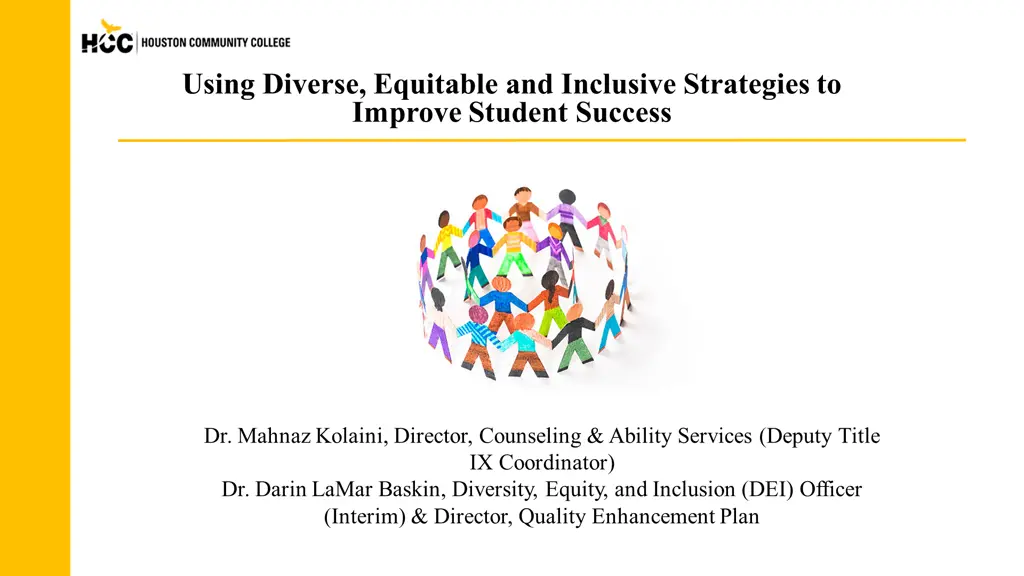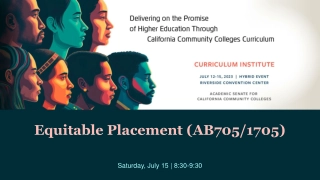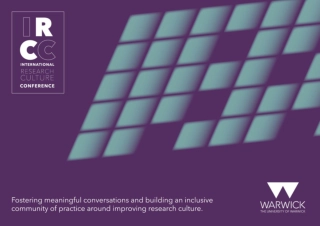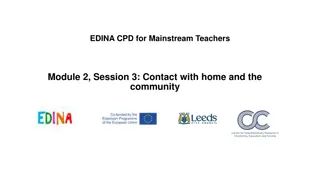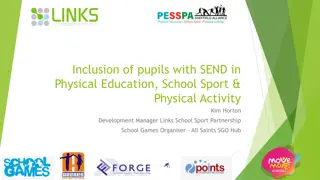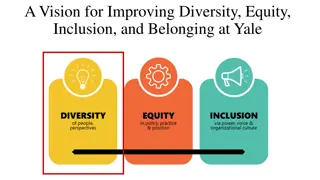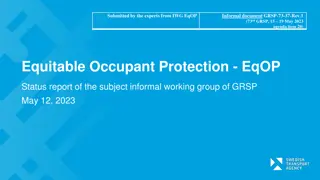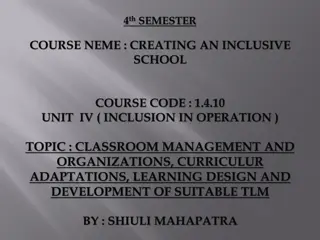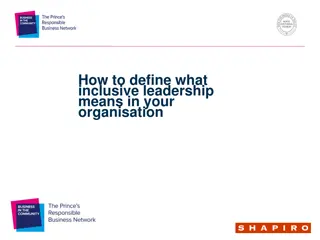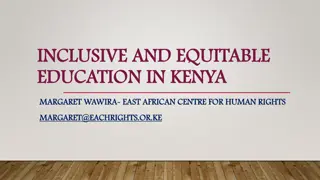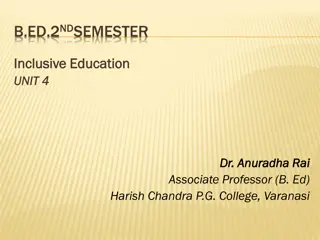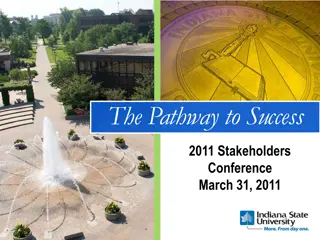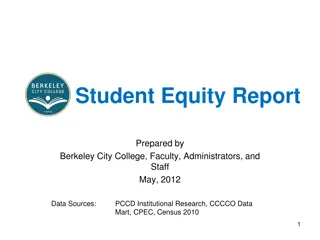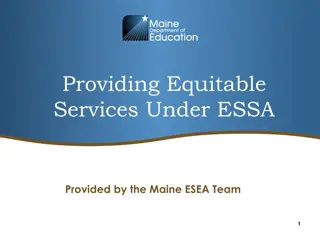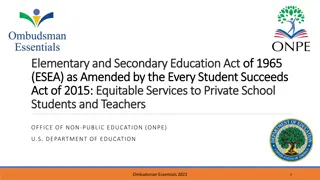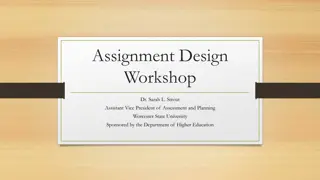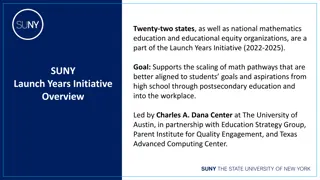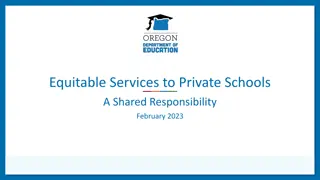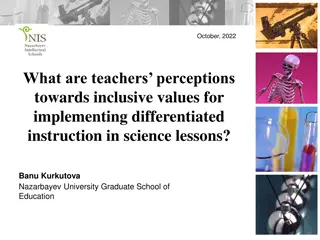Using Diverse, Equitable, and Inclusive Strategies for Student Success
How Houston Community College implements diverse, equitable, and inclusive strategies to improve student success and create an inclusive learning environment.
Download Presentation

Please find below an Image/Link to download the presentation.
The content on the website is provided AS IS for your information and personal use only. It may not be sold, licensed, or shared on other websites without obtaining consent from the author. Download presentation by click this link. If you encounter any issues during the download, it is possible that the publisher has removed the file from their server.
E N D
Presentation Transcript
Using Diverse, Equitable and Inclusive Strategies to Improve Student Success Dr. Mahnaz Kolaini, Director, Counseling & Ability Services (Deputy Title IX Coordinator) Dr. Darin LaMar Baskin, Diversity, Equity, and Inclusion (DEI) Officer (Interim) & Director, Quality Enhancement Plan
Houston Community College Who we are? Data: HCC Student Information System 2020, Academic Dashboard Data: HCC Student Information System 2020,
Houston Community Colleges Mission Statement and Our Vision MISSION STATEMENT Houston Community College is an open-admission, public institution of higher education offering a high-quality, affordable education for academic advancement, workforce training, career development, and lifelong learning to prepare individuals in our diverse communities for life and work in a global and technological society. OUR VISION Houston Community College will equitably deliver relevant, high-quality education and training, ensuring success for all students, our community, economy and beyond. Source: Houston Community College: About HCC https://www.hccs.edu/about-hcc/
HCCs Strategic Plan Embracing Houston s Future STRATEGIC PRIORITIES 1. Student Success: Achieve student success through equity, access and affordability. ** 2. Diversity and Equity: Ensure diversity and equity in all institutional functions** 3. Personalized Learning: Deliver relevant, responsive, personalized learning experiences. 4. Academic Rigor and Quality: Demonstrate institutional commitment to academic rigor and quality. 5. Community Investment: Lessen the student burden and increase the return on the community investment. ** 6. College of Choice: Become the community college of choice in our region for the students, community, business and higher educational institutions ** Strategic Priority paramount to DEI and Student Success Initiatives
Definition of Terms DIVERSITY The mosaic of people who bring a variety of backgrounds, styles, perspectives, values and beliefs as assets to the groups and organizations with which they interact. The differences include demographic characteristics including, but not limited to, race, gender, ethnicity, age, national origin, religion, disability status, sexual orientation, and diversity of personal thoughts. INCLUSION The practice of engaging differences in a manner that makes individuals feel respected, accepted, and valued as part of an organization s culture. Providing equal access to activities, opportunities, and resources for all members of an organization regardless of stakeholder group. Source: Houston Community College: Diversity, Equity and Inclusion https://www.hccs.edu/departments/diversity-equity-and-inclusion/
Definition of Terms EQUITY Equity refers to achieving parity in student educational outcomes, regardless of race and ethnicity. It moves beyond issues of access and places success outcomes for students of color at center focus. SENSE OF BELONGING Belonging is the feeling of security and support when there is a sense of acceptance, inclusion, and identity for a member of a certain group. It is when an individual can bring their authentic self to any situation. When individuals feel like they don t belong, their performance and their personal lives suffer. Creating genuine feelings of belonging for all is a critical factor in improving engagement and performance. Source: University of Southern California Center for Urban Education: https://cue.usc.edu/equity/equity-mindedness/
Equality vs. Equity Source: University of Southern California Center for Urban Education: https://cue.usc.edu/equity/equity-mindedness/
Inclusivity at Houston Community College Student Basic Needs The practice or policy of providing equal access to opportunities and resources for people who might otherwise be excluded or marginalized.
A Closer Look at Our Students HCC Basic Needs Questionnaire 70% 64% 60% 46% 50% 45% 39% 40% 32% 31% 29% 30% 21% 20% 15% 12% 6% 10% 0%
Our Current Resource Food Insecurity Community Health Market Trailers Brick and Mortar Markets HFB MOU Grab & Go Stations On campuses Food For Change Program Basic Needs Items Connection Pallets & Vouchers Monthly Pallets to 6 colleges Basic Needs Items Other networks of support for students Vouchers for large items Donations /Funds Basic Needs Funds for one time donation as well as payroll contribution, Walmart Gift cards. No application, Immediate access Bus Passes Discounted bus passes available to all. # of cards issued since 2020-2022=9,358 Immediate access Student share 60cents a ride CAS Basic Needs Fund Transportation Technology
Food Support and Academic Outcomes Course Success Fall 2022 Food Support 80.35% No Food Support 68.82% 0% 20% 40% 60% 80% 100% Course success includes grades of A, B, C, COM, P, and incompletes that resolved to those grades. Grades of D, F, FX, IP, NCR, W, incompletes that resolved to those grades, and unresolved incompletes are considered not successful. The term in which the student accessed food services determined based on the date of the service (if available). Service that took place between terms is counted in the most recent prior term. Data from PS_DASH_ENROLLMENT_CURR.
Food Support and Academic Outcomes Enrolled Fall 2022 and Persisted to Spring 2023 Food Support 63.04% No Food Support 48.89% 0% 10% 20% 30% 40% 50% 60% 70% 80% 90% 100% Persistence is determined by whether a student enrolled in one term persisted to the next regardless of whether they graduated, transferred or stopped out. It is not a cohort-based measure. The term in which the student accessed food services determined based on the date of the service (if available). Service that took place between terms is counted in the most recent prior term. Data from PS_DASH_ENROLLMENT_CURR.
A Closer Look Enrolled Fall 2022 and Persisted to Spring 2023 100% 81.9% 81.3% 81.1% 80.4% 80% 80.7% 72.5% 72.4% 68.8% 60% No Food Support 40% Food Support 20% 0% Fall 2021 Spring 2022 Summer 2022 Fall 2022 Persistence is determined by whether a student enrolled in one term persisted to the next regardless of whether they graduated, transferred or stopped out. It is not a cohort-based measure. The term in which the student accessed food services determined based on the date of the service (if available). Service that took place between terms is counted in the most recent prior term. Data from PS_DASH_ENROLLMENT_CURR.
Transportation Needs Where we are: Unduplicated students taking at least 1 course or more with a face-to-face component Distinct Locations Fall 2021 Spring 2022 Fall 2022 1 23,215 2 3,963 3 624 4 5 24,649 4,345 737 107 30,831 5,360 814 78 72 7 5 7 Source: OIR Dashboard Data, as of March 27, 2023.
Transportation Needs (Public- METRO) Persistence (Term-to-Long-Term) of Metro Card Users Metro Card, 63.5% PERSISTED No Metro Card, 53.0% 0.0% 10.0% 20.0% 30.0% 40.0% 50.0% 60.0% 70.0% 80.0% 90.0% 100.0%
HCC Basic Needs Questionnaire 1 75.495% (1,374) 1 1 A Closer Look at Our Students 1 Student Persistence Persistence to Next Term Fall 2022 Retained to Spring 2023 1 66.358% (35,140) 1 1 1 1 1 Metro Card Active No Metro Card
HCC Basic Needs Questionnaire 80.616%% (4,999) 1 1 1 Course Course Success Success Fall 2022 1 72.698% (96,805) 1 1 1 1 Metro Card Active No Metro Card
Mental Health and Wellness Care Coordination with Major Mental Health Providers MOU with AVDA (Aid to the Victims of DV) MOU with Harris County Forensic Nurses Examiners MOU with Bridge over Troubled Waters (family and DV) MOU with Michael E. DeBakey VA Medical Center MOU with Legacy Community Health MOU with RecoveryATX (substance use) Memorial Hermann SW (to enroll students & members of community in social services) Daya Houston (DV & and Family Violence)
How to Achieve Student Success Achieving parity in educational outcomes for students of color requires that practitioners critically assess and change their practices to advance student equity (with financial parity being the top practice). For this to happen, there must be a shared understanding that underperforming students (i.e. students of color) have been underserved with inadequate resources that limited their success. To increase student success among these populations, it takes countering interpretations that fail to notice racial inequities and providing more resources and support to students who have not received it.
How do WE plan on Achieving Student Success? Equity-Minded Practitioners Equity-Minded practitioners question their own assumptions, recognize stereotypes that harm student success, and continually reassess their practices to create change.
Building a Sense of Belonging at Houston Community College
Reflection Common Ground Can you think of a time when you met someone very different from yourself only to later find out how much you have in common?
Until we get equity in education, we won't have an equal society. Supreme Court Justice- Judge Sonia Sotomayor
Personal Reading Materials Journal Article: Batiste, H., Denby, R., & Brinson, J. (2022). Cross-cultural mentoring in higher education: the use of a cultural identity development model. Mentoring & Tutoring: Partnership in Learning , 30 (4), 409-433. Szel nyi, K., & Denson, N. (2019). Personal and Institutional Predictors of Work-Life Balance among Women and Men Faculty of Color. The Review of Higher Education , 43 (2), 633-665. Personal Assessments: Project Implicit https://implicit.harvard.edu/implicit/takeatest.html NERCHE Self-Assessment Rubric for the Institutionalization of Diversity, Equity, and Inclusion in Higher Education https://www.wpi.edu/sites/default/files/Project_Inclusion_NERCHE_Rubric-Self-Assessment-2016.pdf Reading Materials Race Talk and the Conspiracy of Silence: Understanding and Facilitating Difficult Dialogues on Race By Derald Wing Sue "White Fragility: Why It's So Hard for White People to Talk About Racism" by Robin DiAngelo So You Want to Talk About Race by Ijeoma Oluo
